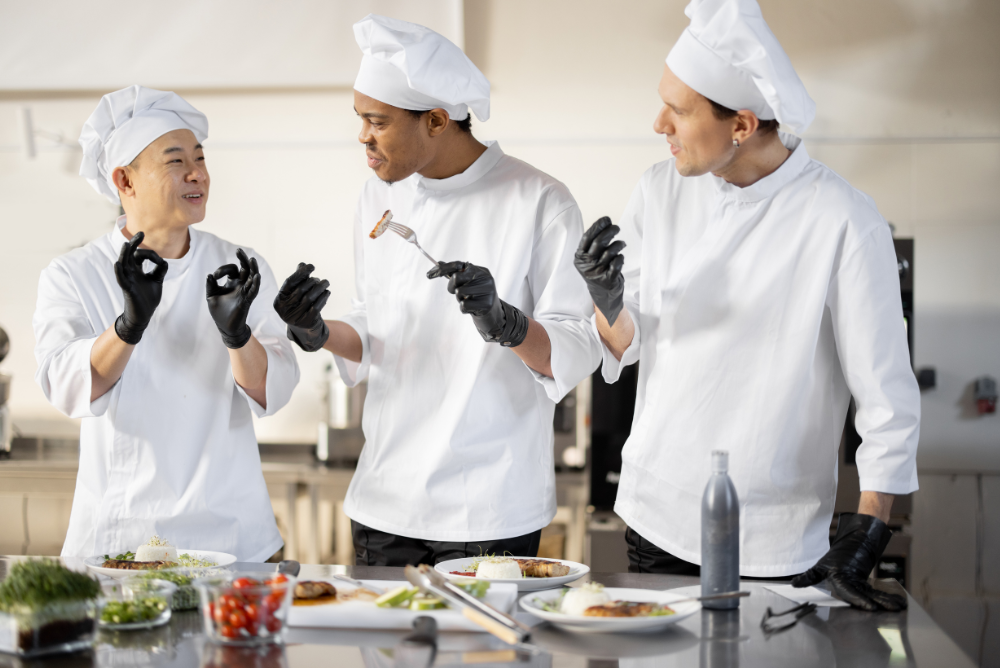Chef uniforms are synonymous with professionalism, and our food memories are often associated with chefs pleasantly serving us in their white aprons. Have you ever thought the chef uniforms that appear so simple may serve many purposes, including assuring the safety and hygiene of a wearer! How? Read this post to know the answers.
Different Components of a Uniform Analyzed A chef's uniform comprises components that add to its utility value and comfort of a wearer. Each uniform component is designed to protect the wearer from discomfort and add to their safety in the kitchen. Before delving into how these components contribute to safety and comfort, let’s see how they bode well in the uniform.
•
The Jacket: Generally, made from cotton mix, heavy cotton, or a polyester material, this component acts as a layer of protection. It is manufactured in white color because it lends a clean and professional look. You can fasten it with stud buttons or Velcro.
•
The Pants: They are worn as bottom wear that protects the wearer and prevents cross-contamination of food. The pants are often designed loose fitting to enable breathability and swift movements in the kitchen.
•
The Apron: These are worn over the jacket and provide additional protection against stains and heat. Earlier, there were limitations in terms of apron design. However, nowadays, they are available in various designs, such as bib aprons, 3-pocket aprons, waiter aprons, and so on. These aprons can also be found in different materials, such as cotton, denim, polyester, etc. Many chefs nowadays prefer customized aprons over plain ones.
•
The Hat: This is one of the most important components of a chef’s uniform and is worn over the head to avoid loose hair from falling into the food item. Once, the chef hats were synonymous with a chef’s position in the kitchen. Longer hats symbolized higher position and vice versa. Nowadays, chefs prefer bandanas, skull caps, hats, and so on.
•
The Shoes: Chefs must stand in the kitchen for long, and comfortable shoes are a key to long working hours. For safety, all chefs should wear slip-resistant shoes with reinforced or steel toecaps.
How Chef Uniforms Help Ensure the Safety and Hygiene of a Chef Chef uniforms come in different styles, sizes, and colors, but they all serve the same purpose - making a wearer feel at ease. The following pointers will help you understand how chef uniforms contribute to this ease, comfort, and safety in the kitchen.
•
Protection from Spills: Chefs regularly work with spices, sauces, and liquids in their kitchen. Although trained to handle these ingredients safely, they may sometimes spill or splatter accidentally. If the chef is not well-equipped, they may sustain injuries from burns or have to continue with messy clothes in the kitchen. The chef's uniform helps them avoid these instances and keep themselves clean and safe. Nowadays, chef uniforms are also available in stain-resistant finishes with reinforced seams.
•
Protection from Burns: Injuries from burns are one of the critical concerns for chefs working in the kitchen. This concern can be easily avoided by wearing chef uniforms made of flame-resistant fabrics like Cotton twill, poly/cotton blends, wool, etc. These fabrics would protect them from accidental burns while operating huge commercial ovens, stovetops, grills, and other hot equipment in the kitchen.
•
Prevention from Food Contamination: Accessories like head caps and beard snoods, as well as aprons with high collars and long sleeves will help prevent sweat droplets, loose hair, and pet hair clinging to clothes from falling into the kitchen or the food, thereby avoiding the instances of cross-contamination. Additionally, chefs abiding by other uniform requirements, such as not wearing jewelry to the kitchen, can prevent contamination.
•
Personal Comfort: A commercial kitchen may feature multiple ovens, hobs, grills, and other heating and grinding equipment. Sometimes, this heat can make a chef uncomfortable, irritable, and prone to mistakes. A well-designed chef uniform can help them stay cool and composed. If made from a comfortable material, these uniforms may help them stay cool and avoid instances of skin irritation. This feeling of comfort will inspire them to make the right decisions and complete their tasks effortlessly with minimal distractions, adding to their performance and safety.
•
Safety Regulations: In the US and many countries, the chefs and people serving or working in food establishments must wear uniforms for safety purposes, maintain hygiene standards, and protect themselves from foodborne illnesses. Compliance with these regulations is essential for food establishments to operate legally.
Commercial kitchen owners and chefs can benefit more by sourcing these chef uniforms and their components from trusted sources like ChefsCloset. The company provides one of the most extensive collections of components for chef uniforms online. With years of experience, they specialize in stocking parts designed to keep the commercial kitchen environments in mind. These components can be chosen and customized to meet your specific branding requirements. Contact the team at ChefsCloset to discuss your customization and chef uniform component requirements.

